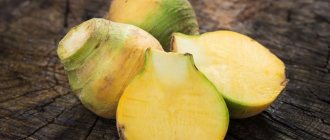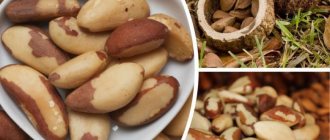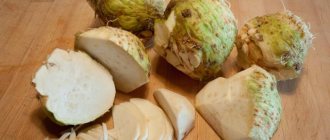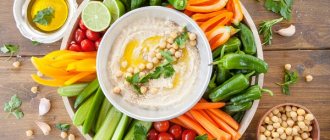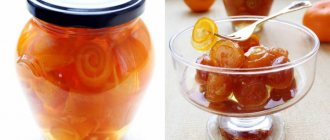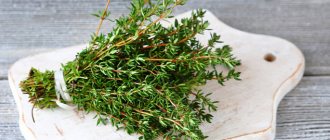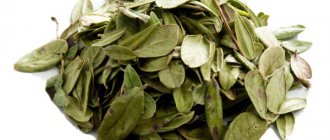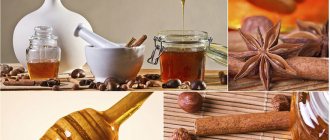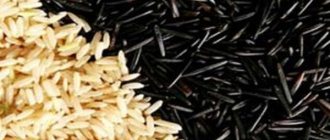Properties of fern
Nutritional value and composition | Vitamins | Minerals
How much does a fern cost (average price per 1 kg)?
Moscow and Moscow region.
350 rub.
The scientific name of this plant comes from pteron, which means “wing” in Greek, and aquila, which means “eagle” in Latin. The leaves of the fern actually somewhat resemble the wings of a huge bird. As you know, the stem of a fern grows underground, and at the end of spring fronds begin to form - young leaves that at first look like a snail, and then, growing and unfolding, resemble a hook.
This plant has long been included in the diet of Far Eastern taiga inhabitants, as well as residents of Korea and Japan. Today, domestic consumers are also showing interest in fern as a food product. By the way, the protein content in fern in its composition and properties is close to those in grain crops, and therefore this product is easily absorbed by the human body. The calorie content of fern, namely 100 grams of plant shoots, averages 34 kcal.
Different peoples of the world know and appreciate not only the beneficial properties of fern, but also its gastronomic qualities. Delicious salads are often prepared based on the shoots and young leaves of fern, and the “snails” themselves are boiled, fried, pickled and salted for the winter, and then used as a seasoning for meat. By the way, cooked fern shoots taste somewhat like mushrooms. However, remember that ferns cannot be eaten without heat treatment.
Harm and contraindications
Real harm comes only from the incorrect use of fern for treatment or nutrition.
The reason is the poisonous properties of the plant. Children, pregnant women, and people with weakened immune systems should not be treated with fern and preparations based on it.
An overdose of drugs is dangerous. Treatment is carried out under the supervision of the attending physician.
Watch a master class on how to prepare a healthy dish from fern leaves at home.
Fern, young shoots
rich in vitamins and minerals such as: vitamin A - 20.1%, beta-carotene - 40.8%, vitamin B2 - 11.7%, vitamin C - 29.6%, vitamin PP - 24.9%, potassium - 14.8%, phosphorus - 12.6%, manganese - 25.5%, copper - 32%
- Vitamin A
is responsible for normal development, reproductive function, skin and eye health, and maintaining immunity. - B-carotene
is provitamin A and has antioxidant properties. 6 mcg of beta carotene is equivalent to 1 mcg of vitamin A. - Vitamin B2
is involved in redox reactions, helps to increase the color sensitivity of the visual analyzer and dark adaptation. Insufficient intake of vitamin B2 is accompanied by impaired condition of the skin, mucous membranes, and impaired light and twilight vision. - Vitamin C
is involved in redox reactions, the functioning of the immune system, and promotes the absorption of iron. Deficiency leads to loose and bleeding gums, nosebleeds due to increased permeability and fragility of blood capillaries. - Vitamin PP
is involved in redox reactions of energy metabolism. Insufficient vitamin intake is accompanied by disruption of the normal condition of the skin, gastrointestinal tract and nervous system. - Potassium
is the main intracellular ion that takes part in the regulation of water, acid and electrolyte balance, and is involved in the processes of conducting nerve impulses and regulating blood pressure. - Phosphorus
takes part in many physiological processes, including energy metabolism, regulates acid-base balance, is part of phospholipids, nucleotides and nucleic acids, and is necessary for the mineralization of bones and teeth. Deficiency leads to anorexia, anemia, and rickets. - Manganese
is involved in the formation of bone and connective tissue, and is part of enzymes involved in the metabolism of amino acids, carbohydrates, and catecholamines; necessary for the synthesis of cholesterol and nucleotides. Insufficient consumption is accompanied by slower growth, disturbances in the reproductive system, increased fragility of bone tissue, and disturbances in carbohydrate and lipid metabolism. - Copper
is part of enzymes that have redox activity and are involved in the metabolism of iron, stimulates the absorption of proteins and carbohydrates. Participates in the processes of providing oxygen to the tissues of the human body. Deficiency is manifested by disturbances in the formation of the cardiovascular system and skeleton, and the development of connective tissue dysplasia.
more hide
You can see the complete directory of the most useful products in the application
The beneficial properties of fern are primarily determined by its amazing ability to remove radiation and toxic substances from the body. The inhabitants of Japan were the first to draw attention to this feature: after the nuclear bombings, the living organisms that easily survived them were ants. To be more precise, it is the species that feeds only on bracken fern.
Subsequently, it turned out that of all the existing varieties of this plant, only 2 are suitable for food, one of them is the bracken fern. It is used as a separate ingredient for various salads, as an unusual seasoning.
Bracken has a fairly low calorie content, which makes it an attractive component of the diet menu. By the way, many nutritionists successfully use this plant in their practice: they recommend that patients add it to salads and meat dishes, drink healthy infusions and decoctions.
The calorie content of bracken is 34 kcal per 100 g. If we talk about the nutritional value of this plant, miraculous in its properties, it is amazing due to its unusual percentage:
- carbohydrates – 5.54 g;
- fat – 0.4 g;
- proteins – 4.55 g.
The rhizome of this plant contains medicinal components:
- tannins, which provide excellent digestion;
- various essential oils and fats;
- flavonoids;
- bracken-tannic, glutamic, aspartic, nicotinic and hydrocyanic acids;
- alkaloids;
- starchy substances and saponins;
- riboflavin, tocopherol and carotene (contained in young shoots);
- various enzymes, in particular glycoside and thiaminase (an enzyme involved in the hydrolysis of thiamine).
The valuable composition of bracken is represented by the following microelements:
- nickel and potassium;
- magnesium, copper and sulfur;
- phosphorus, sodium and manganese;
- calcium and .
The proteins that make up bracken are somewhat similar in properties to grain crops (wheat, oats). But the most important benefit of fern is associated with the high concentration of biologically active elements.
Harm and contraindications
Despite such an abundance of beneficial properties, bracken also has its contraindications. First of all, you should remember that this plant contains toxic substances. This is why you should consult an experienced herbalist or homeopathic doctor before consuming it.
The dosage should be observed during the preparation of the medicine. If you ignore this rule, you may experience nausea, severe dizziness, vomiting, convulsions, and severe headaches.
Even death is possible, especially if you used low-quality shoots or fern leaves for treatment. Have you noticed any of the above symptoms after using the plant? Call a doctor immediately and rinse your stomach thoroughly.
fern with meat
rich in vitamins and minerals such as: vitamin A - 29.9%, beta-carotene - 31.5%, vitamin B2 - 11.9%, vitamin C - 21.2%, vitamin PP - 15.3%, cobalt - 28%, manganese - 17.7%, copper - 16.1%
- Vitamin A
is responsible for normal development, reproductive function, skin and eye health, and maintaining immunity. - B-carotene
is provitamin A and has antioxidant properties. 6 mcg of beta carotene is equivalent to 1 mcg of vitamin A. - Vitamin B2
is involved in redox reactions, helps to increase the color sensitivity of the visual analyzer and dark adaptation. Insufficient intake of vitamin B2 is accompanied by impaired condition of the skin, mucous membranes, and impaired light and twilight vision. - Vitamin C
is involved in redox reactions, the functioning of the immune system, and promotes the absorption of iron. Deficiency leads to loose and bleeding gums, nosebleeds due to increased permeability and fragility of blood capillaries. - Vitamin PP
is involved in redox reactions of energy metabolism. Insufficient vitamin intake is accompanied by disruption of the normal condition of the skin, gastrointestinal tract and nervous system. - Cobalt
is part of vitamin B12. Activates enzymes of fatty acid metabolism and folic acid metabolism. - Manganese
is involved in the formation of bone and connective tissue, and is part of enzymes involved in the metabolism of amino acids, carbohydrates, and catecholamines; necessary for the synthesis of cholesterol and nucleotides. Insufficient consumption is accompanied by slower growth, disturbances in the reproductive system, increased fragility of bone tissue, and disturbances in carbohydrate and lipid metabolism. - Copper
is part of enzymes that have redox activity and are involved in the metabolism of iron, stimulates the absorption of proteins and carbohydrates. Participates in the processes of providing oxygen to the tissues of the human body. Deficiency is manifested by disturbances in the formation of the cardiovascular system and skeleton, and the development of connective tissue dysplasia.
more hide
You can see the complete directory of the most useful products in the application
Fern - in cooking, young shoots of one of the varieties of the herbaceous plant of the same name, usually the male fern (male fern). It grows and is grown as an agricultural crop in temperate regions. It is popular in cooking due to its original taste, which is both similar to asparagus and green beans.
Calorie content
100 grams of young fern shoots contain about 34 kcal.
Compound
The chemical composition of young fern shoots is characterized by a high content of carbohydrates, proteins, vitamins (A, B6, C), minerals (sodium, potassium, calcium, iron, magnesium) and phytonutrients (beta-carotene).
How to cook and serve
As noted earlier, young shoots of fern are used for food purposes. Thanks to their taste, which is simultaneously reminiscent of green beans and asparagus, they have found quite wide application in cooking. This is preceded by a not too complicated preparatory process. First, the surface of the fern shoots is cleared of superficial brown scales, while the lower part of the climbing stem is cut off. After this, they are washed under cold running water and then placed in boiling salt water for 1-2 minutes. This procedure makes the taste less bitter, so it is recommended to repeat it 2-3 times.
Young shoots of fern are eaten exclusively in cooked form. They are prepared in exactly the same way as asparagus and green beans. Most often, fern shoots are stewed and served as a side dish, either separately, seasoned with melted butter, salt and pepper, or together with vegetables for meat, poultry and fish dishes.
How to choose
When choosing young fern shoots, you should take into account the period of their collection, which lasts from April to June. The highest quality ones are distinguished by their bright green color and leaves tightly pressed together.
Storage
Fresh fern shoots should be stored in the refrigerator, first placing them in a tightly closed plastic container, and then eating them within 2-3 days.
Beneficial features
The unique appearance of young fern shoots is surprisingly combined with their chemical composition, which is extremely rich in a number of vital minerals and vitamins, which gives them a lot of beneficial properties. In particular, their consumption improves vision, increases resistance to infectious, inflammatory and oncological diseases, and also normalizes the functioning of the cardiovascular system and gastrointestinal tract.
